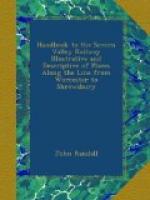The Iron trade, so far as regards the manufacture of bridges, machinery, and general castings, notwithstanding the distance from the iron making districts, is well represented by the Vulcan Works, and those of Messrs. Padmore and Hardy. Other establishments on a large scale have sprung into existence in the city and its suburbs, in which chemistry and machinery, singly or combined, produce results the most astounding. Among them are those of Hill, Evans, and Co., where the visitor wanders amidst enormous vats, from which as many as 1,208,600 gallons of vinegar have been produced in a single year; and those of Lewis, Watkins, and Co., where a large portion of the vinegar is used in preparing pickles, and where hundreds of tons of preserved fruits and jam are annually produced for sale. There are also those of the well-known firm of Lea and Perrin; the chemical works of Webb; the extensive carriage manufactory of McNaught and Smith, and others upon which space forbids us to dwell.
[Old waterworks: 7.jpg]
The Severn supplies the inhabitants with water, which is purified by means of extensive filter-beds at the upper end of Pitchcroft, and then thrown by machinery to the top of Rainbow Hill, a position sufficiently elevated to ensure its distribution over the upper stories of the highest houses. The “Old Waterworks” remain, and, as will be seen from our sketch, form a picturesque object in the landscape. The Severn is, however, no longer the fast-flowing stream poets have described it, but what it has lost in speed it has gained in depth, breadth, and majesty; the locks and weirs at Diglis—the former two abreast, and the latter stretching 400 feet across the stream—giving to it the aspect of a lake, an aspect aided by the appearance upon its surface of a number of swans. Its contrast with itself, whilst yet in its rocky cradle on Plinlimmon, will be seen from the accompanying sketch of Blaen Hafren, or the “Head of the River,” two miles from its source. Anglers will find pleasant spots at which to indulge in the “gentle art,” near Henwick, where the old Worcester monks had weirs; also near Bevere Island, and Holt Castle; at the confluence of the Severn with the Teme (two miles
[Blaen Hafren: 8.jpg]
below Worcester), thence to the tail of Kempsey Lake; and still better near the Rhydd (the seat of Sir E. A. H. Lechmere, Bart.). Worcester is surrounded by very many spots of interest to lovers of natural scenery, to archaeologists, botanists, and geologists. Among those within easy reach, and deserving of special notice, may be mentioned Croome Court, the seat of the Earl of Coventry (nine miles); and Witley Court, backed by the Abberley and Woodbury hills, (ten miles); also Madresfield Court, the seat of the Earl of Beauchamp (six miles); Cotheridge Court, the seat of W. Berkeley, Esq. (four miles); and Strensham village, the birthplace of Butler, the author of “Hudibras” (three




